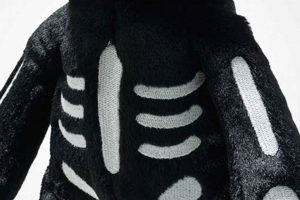A bodysuit, a one-piece, close-fitting undergarment, can be worn beneath clothing for various reasons. Similar to lingerie, it typically covers the torso and crotch, often having snaps or hooks at the crotch for closure. Variations exist, including those with sleeves, those resembling camisoles or tank tops, and those made from different materials like lace, cotton, or silk.
Wearing this type of garment offers several advantages. It can create a smooth silhouette under clothing, minimizing visible lines and lumps. It can also provide a layer of warmth in colder weather. Some individuals find these garments comfortable and supportive. Historically, similar garments have served as foundational layers under complex attire and evolved alongside fashion trends. The versatility of these garments allows them to be worn under various outfits, from casual everyday wear to more formal attire.
This article will further explore the practicalities and stylistic considerations associated with wearing such undergarments. Topics covered will include selecting the correct size and fit, choosing appropriate materials for different seasons and activities, and styling tips for seamlessly integrating them into a variety of wardrobes.
Tips for Wearing Bodysuits
Choosing and wearing a bodysuit comfortably and effectively requires consideration of various factors, from fabric and fit to the intended outer garments.
Tip 1: Consider the Fabric: Material selection impacts comfort and practicality. Cotton is breathable and suitable for everyday wear. Silk and lace offer a luxurious feel for special occasions. Spandex blends provide shaping and flexibility.
Tip 2: Select the Right Size: A properly fitted bodysuit should be snug but not constricting. Incorrect sizing can lead to discomfort and visible lines under clothing. Consult size charts and consider individual body measurements.
Tip 3: Think About the Occasion: The chosen bodysuit should align with the event and attire. A simple, seamless style works well under everyday clothing, while more elaborate designs might be suitable for special occasions.
Tip 4: Layer Appropriately: Bodysuits provide a smooth base layer under various garments. They work well under dresses, skirts, pants, and even sheer tops. Consider the opacity and fit of the outer layers.
Tip 5: Address Potential Issues: Be mindful of bathroom breaks. Bodysuits with snap closures at the crotch offer convenience. Plan outfits accordingly to avoid awkward situations.
Tip 6: Explore Different Styles: Various necklines, sleeve lengths, and leg openings cater to different preferences and outfits. Experiment to discover styles that complement individual body types and fashion choices.
Tip 7: Care and Maintenance: Follow care instructions on the garment label to maintain its shape and quality. Proper washing and drying techniques will prolong the bodysuit’s lifespan.
By considering these tips, one can ensure a comfortable and flattering experience when incorporating bodysuits into their wardrobe. These garments offer a versatile and practical foundation for a wide range of outfits.
In conclusion, the thoughtful selection and application of these guidelines contribute to a positive experience with this versatile garment.
1. Comfort
Comfort plays a crucial role in the decision to wear a bodysuit as an undergarment. Several factors influence comfort levels, impacting the overall experience. Fabric choice is paramount; natural fibers like cotton offer breathability, while synthetics like spandex provide stretch and support. The garment’s fit significantly affects comfort; a bodysuit that is too tight can restrict movement and create uncomfortable pressure points, whereas a loose fit might bunch or wrinkle under clothing. Seamless designs minimize friction against the skin, enhancing comfort, particularly under fitted attire. Temperature regulation is another key aspect of comfort. Certain fabrics, like silk or modal, offer temperature-regulating properties, preventing overheating or chills. Finally, individual sensitivities and preferences influence comfort; some individuals might prefer specific fabrics or styles based on their skin type or personal comfort thresholds.
For instance, a cotton bodysuit provides breathability and comfort for daily wear, while a seamless microfiber option offers a smooth, invisible layer under form-fitting dresses. A thermal bodysuit adds warmth in colder climates, enhancing comfort in low temperatures. However, a poorly fitted bodysuit, regardless of fabric, can cause discomfort and detract from the overall experience. Choosing the correct size and style is essential for maximizing comfort. Likewise, considering the intended outer garments and activity level is crucial; a compression bodysuit might offer support and comfort during exercise, but might feel restrictive during extended periods of sitting or inactivity.
Prioritizing comfort when selecting and wearing a bodysuit ensures a positive experience. Careful consideration of fabric, fit, and intended use allows individuals to harness the benefits of these garments while avoiding potential discomfort. Understanding the interplay of these factors enables informed decisions that contribute to overall well-being and confidence. Discomfort, stemming from ill-fitting garments or inappropriate fabric choices, can negatively impact daily activities and overall confidence. A comfortable undergarment, on the other hand, serves as a supportive and unobtrusive foundation, promoting ease of movement and a positive self-image.
2. Smooth silhouette
A primary motivation for wearing a bodysuit under clothing lies in its ability to create a smooth, streamlined silhouette. This effect is particularly desirable under form-fitting garments where visible lines from underwear can disrupt the intended aesthetic. Achieving a smooth silhouette contributes to a polished and confident appearance.
- Eliminating Panty Lines:
Bodysuits eliminate the visible lines created by traditional underwear, particularly under fitted skirts, pants, or dresses. This creates a clean, unbroken line from waist to thigh, enhancing the overall appearance of the outfit. The absence of panty lines allows clothing to drape more naturally and accentuates the garment’s design rather than the underlying undergarments.
- Smoothing Out Lumps and Bumps:
The close-fitting nature of a bodysuit can smooth out lumps and bumps, creating a more even surface under clothing. This can be particularly beneficial for individuals who desire a more streamlined look or want to minimize the appearance of certain body contours. The compression offered by some bodysuits provides additional smoothing and shaping.
- Enhancing Drape and Fit:
A smooth foundation allows clothing to drape and fit as intended. Without the interruption of visible lines or underlying bulk, garments can hang more naturally and flatter the wearer’s figure. This contributes to a more polished and professional appearance.
- Boosting Confidence:
The confidence derived from a smooth, seamless silhouette can significantly impact how one carries themselves. Feeling comfortable and put-together in one’s clothing promotes self-assuredness and allows individuals to focus on other aspects of their presentation. This psychological benefit contributes to a more positive overall experience.
The creation of a smooth silhouette, achieved through the use of a bodysuit, serves as a foundational element for a polished and confident appearance. By eliminating visible lines, smoothing contours, and enhancing the drape of clothing, the bodysuit facilitates a more streamlined aesthetic, ultimately boosting confidence and contributing to a positive self-image. This aspect of wearing a bodysuit makes it a versatile and practical garment for various occasions and outfits.
3. Warmth
The thermal properties of a bodysuit contribute significantly to its practicality as an undergarment. Wearing a bodysuit can provide an additional layer of insulation, offering warmth in colder temperatures or air-conditioned environments. This aspect expands the garment’s utility beyond shaping and smoothing, making it a versatile option for various climates and situations.
- Fabric and Insulation:
The fabric composition plays a crucial role in the warmth provided by a bodysuit. Materials like wool, fleece, and thermal blends offer superior insulation compared to lighter fabrics like cotton or silk. The thickness of the fabric also contributes to its insulating properties. A thicker bodysuit will naturally provide more warmth than a thinner one. Choosing the appropriate fabric based on the expected temperature and activity level is crucial for maximizing comfort and warmth.
- Layering Potential:
Bodysuits serve as an excellent base layer for layering clothing in colder weather. They fit snugly against the skin, trapping body heat and preventing drafts. This foundational layer allows for the addition of further insulating layers like sweaters, jackets, or coats without adding bulk or restricting movement. The smooth surface of a bodysuit also facilitates layering, preventing clinging or bunching beneath outer garments.
- Temperature Regulation:
While providing warmth, some bodysuits also offer temperature regulation properties. Certain fabrics wick away moisture, preventing overheating and maintaining a comfortable body temperature even during periods of activity. This is particularly beneficial for individuals who experience temperature fluctuations or engage in physical activity in colder environments.
- Seasonal Adaptability:
The availability of bodysuits in various fabrics and thicknesses allows for seasonal adaptability. Lighter fabrics like cotton are suitable for warmer months, while thicker, thermal options provide necessary warmth in colder climates. This versatility makes the bodysuit a practical undergarment year-round.
The ability of a bodysuit to provide warmth enhances its value as a foundational garment. By considering fabric choices and layering potential, individuals can leverage the thermal properties of bodysuits to maintain comfort in various temperatures and climates. This aspect, coupled with the smoothing and shaping benefits, positions the bodysuit as a versatile and practical addition to any wardrobe, extending its use beyond a simple undergarment to a key component of thermal comfort and overall well-being.
4. Support
The concept of “support” plays a significant role in the context of wearing a bodysuit, often referred to as a teddy, under clothing. This support can be both physical and psychological, influencing comfort, confidence, and the overall effectiveness of the garment. The following facets explore the various aspects of support provided by a bodysuit.
- Physical Support:
Bodysuits, particularly those with compression features, offer physical support to the torso and bust. This can be beneficial for individuals seeking additional support for their bust, especially those who prefer not to wear a bra or find traditional bras uncomfortable. The snug fit of a bodysuit can also provide a gentle shaping effect, enhancing the body’s natural contours. This physical support can improve posture and provide a sense of security, particularly during physical activity. For instance, a compression bodysuit can offer support during exercise, minimizing bounce and providing muscle support. Similarly, a shaping bodysuit can smooth and control the midsection, creating a more defined silhouette.
- Bust Support:
Certain bodysuits are designed with built-in bust support, eliminating the need for a separate bra. This can be particularly appealing for individuals seeking a seamless look under clothing or those who find traditional bras constricting. The level of bust support varies depending on the bodysuit’s design and construction. Some offer light support suitable for everyday wear, while others provide more substantial support suitable for higher-impact activities. For example, a bodysuit with molded cups or underwire can offer similar support to a traditional bra, while a shelf-bra bodysuit provides lighter support suitable for lounging or low-impact activities. The choice of bodysuit depends on individual bust size and support needs.
- Psychological Support:
The smoothing and shaping properties of a bodysuit can contribute to a sense of confidence and self-assuredness. By creating a streamlined silhouette and minimizing visible lines or bulges, the bodysuit can enhance the wearer’s perception of their body image. This psychological boost can translate into greater confidence in social situations and professional settings. Knowing that one’s clothing fits smoothly and comfortably can reduce self-consciousness and allow for greater focus on other aspects of presentation. For example, wearing a smoothing bodysuit under a form-fitting dress can enhance confidence by creating a sleek and polished appearance.
- Foundation for Clothing:
A bodysuit provides a smooth and supportive foundation for clothing, enhancing the fit and drape of outer garments. This can be particularly beneficial for sheer or clingy fabrics where underlying undergarments might be visible. The bodysuit acts as a second skin, creating a seamless base upon which other clothing layers can be built. This allows garments to hang more naturally and flatter the wearer’s figure, further contributing to a polished and put-together appearance. For example, a bodysuit can prevent clinging and static with silk dresses or skirts, ensuring a smooth and comfortable fit.
The various aspects of support provided by a bodysuit contribute significantly to its versatility and practicality as an undergarment. From physical support and shaping to the psychological boost of a smooth silhouette and the foundational support for clothing, the bodysuit offers a range of benefits that extend beyond simple coverage. The careful selection of a bodysuit based on individual needs and preferences can enhance comfort, confidence, and the overall effectiveness of one’s wardrobe.
5. Fabric Choice
Fabric choice is a critical factor influencing the practicality and comfort of wearing a bodysuit, often referred to as a teddy, under clothing. The material’s properties directly impact comfort, breathability, and the garment’s overall effectiveness. Selecting an appropriate fabric depends heavily on the intended purpose, climate, and the type of outer clothing worn.
Different fabrics offer distinct advantages. Natural fibers, such as cotton, are known for breathability and absorbency, making them suitable for everyday wear, particularly in warmer climates. Cotton bodysuits can prevent overheating and maintain comfort throughout the day. Silk, while delicate, provides a luxurious feel and can be appropriate for special occasions. Its smooth texture minimizes friction under clothing. Synthetic fabrics like spandex offer stretch and recovery, making them ideal for form-fitting bodysuits intended to create a smooth silhouette. Spandex blends also offer durability and shape retention, ensuring the bodysuit maintains its fit over time. Modal, a semi-synthetic fabric derived from wood pulp, offers a combination of softness, breathability, and drape, making it a comfortable and versatile option for various situations.
Practical considerations related to fabric choice include the potential for irritation, thermal properties, and care requirements. Some individuals may experience sensitivities to certain synthetic fabrics. Choosing hypoallergenic materials, like organic cotton, can mitigate these issues. The fabric’s weight and weave determine its thermal properties. Lighter fabrics are suitable for warmer temperatures, while heavier fabrics offer insulation in colder climates. Care requirements vary depending on the fabric composition. Some fabrics require delicate washing, while others are machine washable. Understanding these factors allows for informed decisions that prioritize both comfort and practicality.
6. Occasion Suitability
Occasion suitability dictates garment choices, including the appropriateness of wearing a bodysuit, sometimes called a teddy, under clothing. The context of the event, level of formality, and expected dress code influence whether a bodysuit is a practical and appropriate choice. A bodysuit’s seamless design and smoothing capabilities make it suitable for situations where a polished and streamlined appearance is desired, such as under form-fitting dresses or professional attire. Conversely, more casual or intimate settings might allow for less structured undergarments. Consideration of occasion suitability ensures attire aligns with the event’s tone and avoids wardrobe faux pas.
For example, a simple, seamless bodysuit provides a smooth base under a cocktail dress for a semi-formal event. Its invisibility under the dress ensures a clean, polished look. However, a heavily embellished or lace bodysuit might be inappropriate for a professional work environment, even under more conservative attire. Similarly, a thermal bodysuit, while practical for warmth in cold weather, might be unsuitable for a summer wedding or a beach outing. The occasion’s context and dress code should always guide undergarment choices. Wearing a bodysuit intended for athletic activities under formal wear demonstrates a lack of attention to occasion suitability. Such choices can detract from the overall impression and convey a lack of understanding of social norms related to dress codes.
Understanding occasion suitability demonstrates an awareness of social etiquette and respect for the event’s context. Careful consideration of the event’s formality, dress code, and overall atmosphere informs undergarment choices, including whether a bodysuit is appropriate. This understanding allows individuals to present themselves appropriately, enhancing their confidence and ensuring their attire aligns with social expectations. Ignoring occasion suitability can lead to uncomfortable situations or detract from one’s overall presentation, highlighting the importance of considering this aspect when deciding whether to wear a bodysuit under clothing.
7. Outfit Coordination
Outfit coordination is paramount when considering a bodysuit as a foundational garment. The interplay between the bodysuit and the intended outer attire directly impacts the overall aesthetic. Key considerations include fabric opacity, garment fit, and stylistic cohesion. A lack of coordination can lead to visible lines, awkward bunching, or a mismatched appearance, negating the benefits of wearing a bodysuit. Conversely, careful coordination ensures a smooth, polished look, enhancing the overall outfit.
Fabric opacity is crucial. A sheer or thin outer garment necessitates a seamless and color-appropriate bodysuit to avoid unwanted visibility. For example, a dark-colored bodysuit under a light-colored, thin dress would create a distracting contrast. Similarly, a textured or patterned bodysuit might show through a tight-fitting, sheer top. Garment fit also plays a significant role. A loose-fitting bodysuit might bunch under tight clothing, while a tight-fitting bodysuit can create unwanted lines or bulges under loose clothing. The bodysuit should complement the fit of the outer garment, creating a smooth, uninterrupted silhouette. Stylistic cohesion is essential for a polished appearance. A lace bodysuit might clash with a casual t-shirt and jeans, while a sporty bodysuit might not suit a formal dress. The bodysuit’s style should align with the overall aesthetic of the outfit.
Understanding the relationship between outfit coordination and bodysuit selection is crucial for achieving a successful and polished look. Careful consideration of fabric, fit, and style ensures the bodysuit enhances the outfit rather than detracting from it. This attention to detail elevates the bodysuit from a simple undergarment to a key component of a well-coordinated ensemble, maximizing its potential to create a smooth, flattering, and stylish silhouette.
Frequently Asked Questions about Bodysuits
This section addresses common queries regarding the use of bodysuits as undergarments, offering practical guidance for selecting, wearing, and caring for these versatile garments.
Question 1: What are the primary benefits of wearing a bodysuit under clothing?
Bodysuits offer several advantages, including creating a smooth silhouette, eliminating visible panty lines, providing an extra layer of warmth, and offering support. They also serve as a versatile base layer under various outfits.
Question 2: How does one choose the correct bodysuit size?
Proper sizing is crucial for comfort and effectiveness. Consulting size charts, considering individual body measurements, and understanding the stretch and recovery of the fabric are essential for selecting the correct size. A well-fitted bodysuit should be snug but not constricting.
Question 3: Are there specific fabrics recommended for different seasons?
Fabric choice depends on climate and activity level. Breathable materials like cotton are suitable for warmer weather, while thermal fabrics offer insulation in colder temperatures. Moisture-wicking fabrics are beneficial for physical activity.
Question 4: Can bodysuits be worn under any type of clothing?
Bodysuits are versatile and can be worn under various garments, including dresses, skirts, pants, and even sheer tops. Consideration of fabric opacity and garment fit is crucial for a seamless appearance. Certain bodysuit styles might be more suitable for specific outfits.
Question 5: How should bodysuits be cared for to maintain their shape and quality?
Following care instructions on the garment label is vital for preserving the bodysuit’s shape and quality. Proper washing and drying techniques, including appropriate water temperature and drying methods, will prolong the garment’s lifespan.
Question 6: What are some common misconceptions about wearing bodysuits?
A common misconception is that bodysuits are uncomfortable or restrictive. With proper sizing and fabric selection, bodysuits can be comfortable and offer a variety of benefits. Another misconception is that they are difficult to use in restrooms; however, many styles feature convenient closures for ease of use.
Careful consideration of these frequently asked questions provides a comprehensive understanding of the practicalities and benefits of incorporating bodysuits into one’s wardrobe. Addressing these common queries equips individuals with the knowledge to make informed choices regarding bodysuit selection and use.
The subsequent section delves further into specific styling tips for various body types and occasions, offering practical guidance for maximizing the versatility of bodysuits.
Conclusion
The exploration of bodysuit utility as an undergarment reveals its significant contributions to comfort, style, and overall wardrobe versatility. Key benefits include creating a smooth silhouette, offering support, providing warmth, and serving as a seamless foundation under various outfits. Fabric choice, occasion suitability, and outfit coordination are critical factors influencing the effectiveness and appropriateness of wearing a bodysuit. Addressing potential concerns regarding comfort and practicality highlights the adaptability of this garment to diverse needs and preferences.
The bodysuit’s evolution as a foundational undergarment underscores its enduring relevance in contemporary fashion. Its adaptability to changing styles and its capacity to enhance both comfort and aesthetics solidify its position as a valuable wardrobe staple. Continued exploration of fabric technology and design innovation promises further enhancements to the bodysuit’s functionality and versatility, ensuring its enduring presence in the evolving landscape of undergarments.







